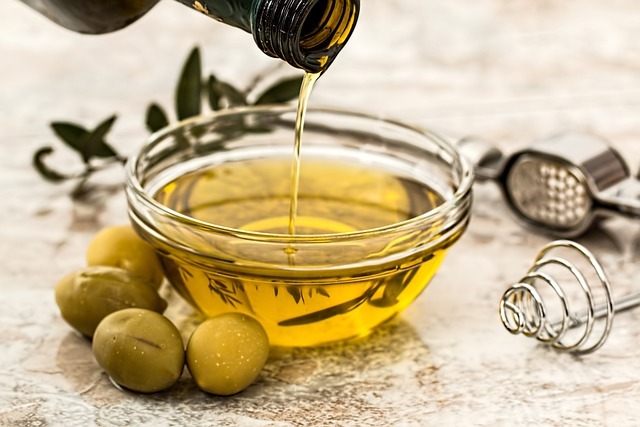
Updated June 30, 2024
A Comprehensive Overview of Oleic Acid Health Advantages
Introduction
Omega-9 monounsaturated fatty acid oleic acid is a common component of many everyday foods. It’s found in olive oil, avocados, and certain nuts. Despite its ubiquity, many people are unaware of the numerous health benefits associated with this fatty acid. This article aims to shed light on the benefits of oleic acid and why it should be a part of your diet.
What is Oleic Acid?
Before delving into the benefits, it’s essential to understand what oleic acid is. It’s a monounsaturated fat with one double bond in its fatty acid chain. This structure allows it to remain stable at higher temperatures, making it a perfect choice for cooking. The primary fatty acid in olive oil is oleic acid. it’s also found in canola, peanut, sunflower, and various nuts and seeds.
Oleic acid belongs to the omega-9 fatty acid family, meaning its first double bond is situated nine carbons from the fatty acid chain’s omega end. Chemically, it consists of an 18-carbon chain with a cis-double bond at the ninth carbon from the omega end. This chemical structure is what gives oleic acid its health benefits.
Oleic Acid Benefits 1: Lowering Bad Cholesterol
One of the most significant benefits of oleic acid is its potential to improve heart health. Research has shown that diets rich in monounsaturated fats like oleic acid can help reduce levels of low-density lipoprotein (LDL), often referred to as ‘bad’ cholesterol, while maintaining or even increasing levels of high-density lipoprotein (HDL), or ‘good’ cholesterol.
This effect is thought to occur because oleic acid helps remove excess cholesterol from the body by forming bile acids. It also may help prevent the oxidation of LDL particles, which is a key step in the development of atherosclerosis. Additionally, oleic acid helps maintain the fluidity of cell membranes, allowing for a better flow of nutrients and waste.
By increasing the HDL to LDL cholesterol ratio, oleic acid helps prevent the buildup of artery plaque, which can cause heart disease and stroke. Replacing saturated fats with oleic acid has lowered the likelihood of cardiovascular events like heart attacks.
Health Benefits of Oleic Acid
1. Cardiovascular Health
Oleic acid promotes heart health through:
Blood Pressure Regulation: It helps regulate blood pressure by improving blood vessel dilation and constriction and maintaining healthy blood flow.
Cholesterol Management: Diets rich in oleic acid are linked to decreased LDL cholesterol levels and potentially increased HDL cholesterol, which is beneficial for cardiovascular health.
Anti-Inflammatory Effects: Oleic acid reduces inflammation by inhibiting pro-inflammatory compounds and enhancing anti-inflammatory cytokines, lowering heart disease risk.
2. Weight Management
Oleic acid aids in weight management by:
– Increasing satiety, which can reduce overeating and snacking.
– Stimulating fat burning through the production of compounds involved in fat breakdown.
– Inhibiting enzymes involved in fat synthesis, according to some research.
3. Skin Health
Topical application of oleic acid benefits skin health by:
– Maintaining skin barrier integrity and hydration.
– Protecting against environmental damage, including UV radiation.
– Promoting collagen formation and reducing signs of ageing.
– Aiding in wound healing and helping with skin conditions like eczema.
4. Brain Health
Emerging research indicates oleic acid benefits brain health by:
– Repairing and maintaining the myelin sheath that protects nerve cells.
– Supporting neurotransmitter formation and nerve cell communication.
– Higher oleic acid diets are associated with better cognitive function and lower rates of cognitive decline.
5. Potential Cancer Prevention
Some studies suggest a potential link between oleic acid intake and reduced cancer risk:
– Higher blood levels of oleic acid are associated with a lower risk of bladder cancer.
While oleic acid offers numerous health benefits, it’s often found with other beneficial compounds in foods like olive oil. The synergistic effects of these components contribute to the overall health benefits observed in diets rich in oleic acid, such as the Mediterranean diet.
The Psychology of Oleic Acid: Harnessing Behavioral Insights for Health
Understanding the psychological aspects of oleic acid consumption can provide valuable insights into its potential benefits. Behavioural psychology, including concepts like mass psychology and cognitive biases, can shed light on how oleic acid impacts our health and well-being.
1. Cognitive Bias and Oleic Acid Perception: The availability heuristic, a cognitive bias where people rely on readily available information, may influence how individuals perceive oleic acid’s benefits. As more positive research emerges, people might overestimate its effects, potentially leading to increased consumption and health benefits.
2. Social Proof and Oleic Acid Adoption: The principle of social proof suggests that people are more likely to adopt behaviours they see others performing. As oleic acid gains popularity, more individuals may incorporate it into their diets, potentially amplifying its health benefits across populations.
3. Framing Effect and Oleic Acid Marketing: How oleic acid’s benefits are framed can significantly impact its adoption. Positive framing that emphasizes heart health and longevity may increase its appeal and consumption.
4. Placebo Effect and Oleic Acid: The placebo effect, where belief in a treatment’s efficacy can lead to real physiological changes, may play a role in oleic acid’s benefits. Strong belief in its health-promoting properties could potentially enhance its actual effects.
5. Habit Formation and Oleic Acid Consumption: Understanding the psychology of habit formation can help individuals incorporate oleic acid-rich foods into their daily routines, maximizing potential health benefits over time.
By considering these psychological factors, individuals and health professionals can better understand and leverage oleic acid’s potential benefits, potentially enhancing its positive impact on health outcomes.
Synergistic Effects: Enhancing Oleic Acid’s Benefits
While oleic acid offers numerous health benefits, its effects can be amplified with specific vitamins, supplements, and foods. These synergistic relationships can enhance the overall impact on health and well-being.
1. Vitamin E and Oleic Acid: Vitamin E, an antioxidant, works synergistically with oleic acid to protect cell membranes from oxidative damage. Foods rich in both, like almonds and avocados, may offer enhanced cardiovascular protection.
2. Omega-3 Fatty Acids and Oleic Acid: Combining oleic acid with omega-3 fatty acids, found in fish oil or flaxseed, may provide a more potent anti-inflammatory effect, potentially offering greater protection against chronic diseases.
3. Polyphenols and Oleic Acid: Polyphenols, found in foods like berries and green tea, can enhance the antioxidant properties of oleic acid, potentially offering more excellent protection against oxidative stress and inflammation.
4. Fiber and Oleic Acid: High-fiber foods consumed alongside oleic acid-rich foods may enhance their cholesterol-lowering effects by promoting better lipid metabolism.
5. Probiotics and Oleic Acid: Emerging research suggests that probiotics may enhance the absorption and utilization of oleic acid in the gut, potentially amplifying its health benefits.
6. Curcumin and Oleic Acid: Combining curcumin (found in turmeric) and oleic acid may offer enhanced anti-inflammatory and antioxidant effects, potentially providing excellent protection against chronic diseases.
By strategically combining oleic acid with these complementary nutrients and compounds, individuals may maximize its health-promoting effects and achieve greater overall well-being.
Conclusion
Oleic acid, the monounsaturated fat found in various foods, emerges as a powerful ally in the quest for optimal health. From promoting heart health and reducing inflammation to supporting skin vitality and potentially aiding in weight management, oleic acid offers diverse benefits that can significantly impact our well-being.
As we’ve explored, the power of oleic acid extends beyond its individual properties. We can unlock its full potential by understanding the psychological factors influencing its consumption and leveraging synergistic relationships with other nutrients. This holistic approach to incorporating oleic acid into our diets enhances its effectiveness and paves the way for a more comprehensive and sustainable approach to health.
Remember, the journey to better health is not just about individual nutrients or quick fixes. It’s about creating a balanced, informed approach to nutrition that considers the complex interplay between different foods, our bodies, and our minds. By embracing oleic acid as part of a broader, mindful approach to eating, we open the door to a healthier, more vibrant life.
As you move forward, consider how you can strategically incorporate oleic acid-rich foods into your diet, paying attention to potential synergies and psychological factors that can enhance its benefits. Whether drizzling extra virgin olive oil over your salad, snacking on avocados, or cooking with high-oleic sunflower oil, every small step can significantly improve your overall health and well-being.
Embrace the power of oleic acid, and let it be a catalyst for a more informed, balanced, and health-conscious lifestyle. Your body – and your future self – will thank you for it.
References
1. Covas, M.I., Konstantinidou, V. and Fitó, M., 2009. Olive oil and cardiovascular health. Journal of Cardiovascular Pharmacology, 54(6), pp.477-482.
2. Terés, S., Barceló-Coblijn, G., Benet, M., Álvarez, R., Bressani, R., Halver, J.E. and Escribá, P.V., 2008. Oleic acid content is responsible for the reduction in blood pressure induced by olive oil. Proceedings of the National Academy of Sciences, 105(37), pp.13811-13816.
3. Sales-Campos, H., Souza, P.R., Peghini, B.C., da Silva, J.S. and Cardoso, C.R., 2013. An overview of the modulatory effects of oleic acid in health and disease. Mini reviews in medicinal chemistry, 13(2), pp.201-210.
4. Gillingham, L.G., Harris-Janz, S. and Jones, P.J., 2011. Dietary monounsaturated fatty acids are protective against metabolic syndrome and cardiovascular disease risk factors. Lipids, 46(3), pp.209-228.
5. Carvajal-Zarrabal, O., Nolasco-Hipolito, C., Aguilar-Uscanga, M.G., Melo-Santiesteban, G., Hayward-Jones, P.M. and Barradas-Dermitz, D.M., 2014. The oleic acid content of a meal promotes oleoyl ethanolamide response and reduces subsequent energy intake in humans. Nutrition Research, 34(3), pp.204-210.
6. Guillaume, C., Padilla, M., Legros, J.J., Margaritis, I., Schmitt, L. and Tordi, N., 2010. Oleic acid, the main monounsaturated fatty acid of olive oil, suppresses Her-2/neu (erbB-2) expression and synergistically enhances the growth inhibitory effects of trastuzumab (HerceptinTM) in breast cancer cells with Her-2/neu oncogene amplification. Annals of Oncology, 22(3), pp.704-710.
7. Palomer, X., Pizarro-Delgado, J., Barroso, E. and Vázquez-Carrera, M., 2018. Palmitic and oleic acid: the yin and yang of fatty acids in type 2 diabetes mellitus. Trends in Endocrinology & Metabolism, 29(3), pp.178-190.
8. Pereira, T., Malheiro, R., Coelho, M., Kozlova, E.V., Alves, V.D., Teixeira, J.A. and Pereira, J.A., 2019. Development of novel oleic acid derivatives as promising agents for inflammatory disorders. European Journal of Medicinal Chemistry, 183, p.111702.












